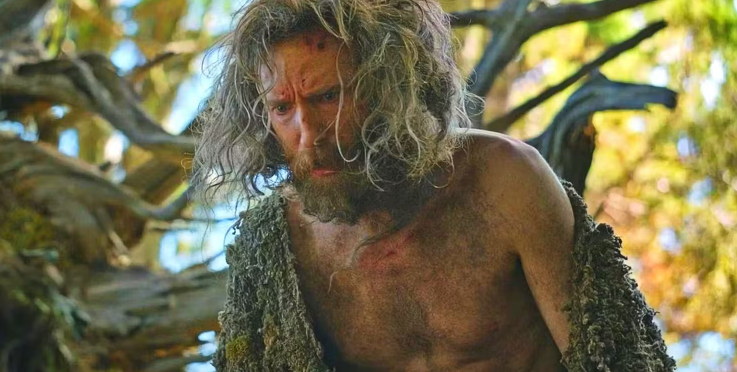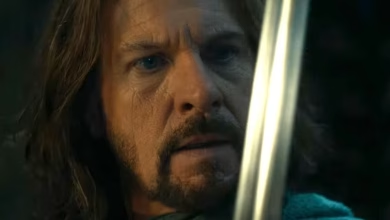Every Gandalf Reference in The Rings of Power, Explained
The Stranger quoted Gandalf in the season finale of The Lord of the Rings: The Rings of Power, but this was not the first reference to the Wizard.
The first season of Prime Video’s The Lord of the Rings: The Rings of Power featured many characters. Some were familiar to fans of J. R. R. Tolkien’s novels or Peter Jackson’s film adaptations, such as Galadriel and Elrond. Others were more obscure characters from Tolkien’s legendarium, like Tar-Miriel, and others still were original characters created for the series, like Arondir. But fans struggled to place a certain character into one of these categories: the Stranger, portrayed by Daniel Weyman. Ever since he plummeted from the sky in the first episode, “A Shadow of the Past,” the internet has been abuzz with speculation about the Stranger’s identity. There were theories that he was anyone ranging from Gandalf to Sauron, the latter being what The Rings of Power’s enigmatic mystics believed.
However, the final episode, “Alloyed,” revealed that the mystics were mistaken. After the Stranger turned against them, one of the mystics referred to him as “The other, the Istar.” The Istari were the five Wizards — including Saruman, Gandalf, and Radagast — from Tolkien’s legendarium. Later in the same episode, the Stranger said, “When in doubt, Elanor Brandyfoot, always follow your nose.” This was a nearly verbatim quotation of a line that Gandalf spoke in Jackson’s The Lord of the Rings: The Fellowship of the Ring: “If in doubt, Meriadoc, always follow your nose.” This seemed to confirm that the Stranger was a younger version of Gandalf, and it was far from the only reference to the Wizard in The Rings of Power.
The Stranger Called Back to Iconic Gandalf Scenes
In the episode “Adrift,” Nori startled the Stranger. He stood up and yelled, suddenly seeming taller than before. The trees bent to close in around the Stranger and Nori, and darkness enveloped the surrounding area. It was an eerie scene reminiscent of another from Jackson’s The Fellowship of the Ring. When Bilbo refused to part with the One Ring, Gandalf yelled, “Bilbo Baggins! Do not take me for some conjurer of cheap tricks! I am not trying to rob you!” Like the Stranger in The Rings of Power, he seemed to tower over Bilbo, and the room grew dark. Both scenes even featured the sound of creaking wood to accentuate the power of the speakers’ words. After these scenes, the Stranger and Gandalf calmed down and had nicer moments with their diminutive friends; the Stranger shared a snack of snails with Nori, and Gandalf bid a heartwarming farewell to Bilbo.
That was not the first Gandalf reference in the episode. Before this, the Stranger had drawn a mysterious symbol on a log. It was later revealed to be the shape of a constellation for which he was searching, but it resembled something else. Some sharp-eyed fans noticed that it looked like a backward version of Gandalf’s signature from The Lord of the Rings: the Dwarvish rune for the letter “G.” In Jackson’s The Hobbit: An Unexpected Journey, Gandalf used a nail on the bottom of his staff to scratch this rune on the front door of Bilbo’s Hobbit hole. This was how Thorin’s Company of Dwarves was able to find Bilbo’s house. Even if the similarity between the shape of the constellation and the Dwarvish rune was coincidental, these scenes showed that both the Stranger and Gandalf liked to carve symbols into wood.
The Stranger Shared Magical Abilities With Gandalf

Near the end of “Adrift,” the Stranger interacted with some fireflies. He caused them to fly out of the Harfoots’ lanterns, and then he caught some of them and whispered to them in an unknown language. In response, the fireflies formed the shape of the constellation. Gandalf never interacted with fireflies in The Hobbit or The Lord of the Rings, but he did befriend a different winged insect. In Jackson’s films, Gandalf used a moth to send messages to the Great Eagles. For example, when he was trapped in the tower of Orthanc in The Fellowship of the Ring, he caught a moth and whispered to it in an unknown language, much like the Stranger did to the fireflies. The moth flew away and alerted Gwaihir the Great Eagle, who came to rescue Gandalf from Saruman’s imprisonment.
The Stranger’s fight with the mystics in “Alloyed” contained many allusions to Gandalf. He wielded a staff, which was the trademark tool of The Lord of the Rings’ Wizards in both the novel and the films. He also made use of light-based magic, which was a staple of Gandalf’s repertoire. The battle was particularly reminiscent of Gandalf’s showdown with Sauron in Jackson’s The Hobbit: The Desolation of Smaug. He also told the mystics, “From shadow you came, to shadow I bid you return!” This mirrored a line that Gandalf said to the Balrog in The Fellowship of the Ring film: “Go back to the shadow!” When he finally defeated the mystics, they dissolved into moths, yet another reference to Gandalf’s insect friend.
The Stranger Might Mark a Departure From The Lord of the Rings’ Canon

There were several other nods to Gandalf throughout the series. When the Stranger first appeared, he lay naked on the ground in the middle of a fiery crater, just as Gandalf did in the snow after his resurrection as Gandalf the White. The Stranger went on to form a close bond with the Harfoots, the ancestors of the hobbits, whom Gandalf loved. He battled a pack of wolves to protect Nori, and Gandalf similarly fended off a pack of Wargs to defend Thorin’s Company in The Hobbit. The Stranger even created a shock wave by slamming the ground as Gandalf did in his fight against the Balrog on the Bridge of Khazad-dûm, though, unlike Gandalf, he did so with his hand and seemingly hurt himself in the process. In addition to light, the Stranger and Gandalf both showed an affinity for elemental magic; the former caused the wind to blow, turned water into ice, and grew plants, while the latter cracked boulders, summoned lightning, created fire, and even helped Elrond flood a river.
However, none of these references guarantee that the Stranger is Gandalf. There is a glaring issue compared to Tolkien’s lore: the Istari did not arrive until about a thousand years into the Third Age, while The Rings of Power takes place in the middle of the Second Age. The reason that the Istari came to Middle-earth was to deal with Sauron’s return after his defeat in the War of the Last Alliance, which has not yet happened in the series. The mystics were mistaken about the Stranger’s identity once, so they might have also been wrong about him being an Istar. Further, the Stranger’s mission in the second season of The Rings of Power is to go to Rhûn, which was the Blue Wizards’ duty rather than Gandalf’s in Tolkien’s writing. On the off chance that the Stranger is not Gandalf, the real Gandalf will likely make an appearance at some point. Though The Rings of Power tells its own story, it taps into nostalgia for the films, hence Sauron’s armor and the Balrog looking so similar to Jackson’s interpretations. Since Gandalf is an ancient, immortal Maia, he is the only member of the Fellowship who could feasibly appear in The Rings of Power’s time frame, even if he needs to do so several centuries early.



